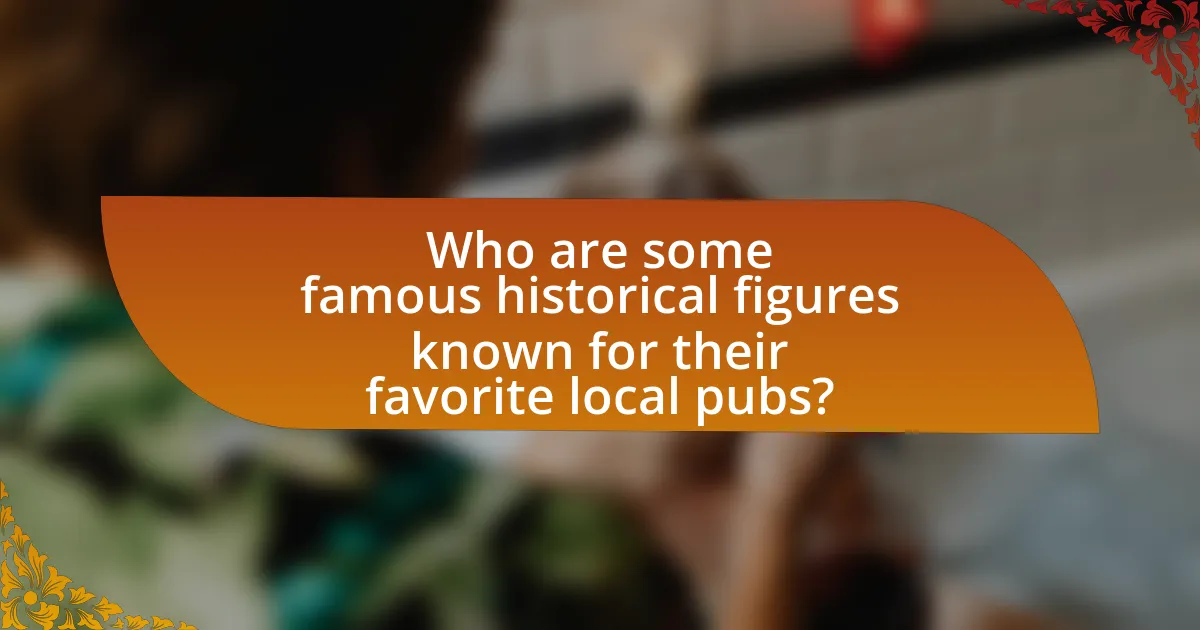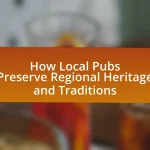The article explores the connections between famous historical figures and their favorite local pubs, highlighting notable patrons such as Charles Dickens and Winston Churchill. It examines the role of these pubs as social hubs that facilitated networking, discussion, and decision-making among influential individuals. Key events that occurred in these establishments, such as the signing of the Treaty of Paris, are discussed, along with the characteristics of the pubs that attracted these figures. The article also delves into the culinary preferences of these historical figures and how their choices reflect their personalities and the eras they lived in, ultimately emphasizing the ongoing legacy of these pubs in contemporary society.

Who are some famous historical figures known for their favorite local pubs?
Famous historical figures known for their favorite local pubs include Charles Dickens, who frequented the Cheshire Cheese in London, and Winston Churchill, who often visited the Red Lion in Westminster. Dickens enjoyed the atmosphere and literary connections of the Cheshire Cheese, a pub that has been in operation since the 16th century, while Churchill’s choice of the Red Lion reflects his fondness for the establishment’s proximity to Parliament and its historical significance as a meeting place for politicians.
What role did local pubs play in the lives of these historical figures?
Local pubs served as crucial social hubs for historical figures, providing spaces for networking, discussion, and relaxation. These establishments often facilitated informal gatherings where influential individuals could exchange ideas, forge alliances, and engage in political discourse. For instance, in 18th-century England, pubs were frequented by writers and politicians, such as Samuel Johnson and James Boswell, who used these venues to debate and share literary and philosophical insights. The convivial atmosphere of pubs allowed for the blending of social and intellectual pursuits, significantly impacting the cultural and political landscape of the time.
How did the social atmosphere of pubs influence their decisions?
The social atmosphere of pubs significantly influenced the decisions of famous historical figures by providing a communal space for discussion, networking, and the exchange of ideas. In these environments, individuals often engaged in debates and shared perspectives that shaped their political and social choices. For instance, the convivial setting of a pub allowed figures like Winston Churchill to gather support and rally allies, as the informal atmosphere encouraged open dialogue and collaboration. Historical accounts indicate that many pivotal decisions, such as those related to policy and strategy, were often made in the relaxed yet stimulating environment of local pubs, highlighting their role as crucial venues for decision-making among influential leaders.
What specific events occurred in these pubs that shaped history?
Specific events that occurred in pubs frequented by famous historical figures include the signing of the Treaty of Paris in 1783 at Fraunces Tavern in New York, which ended the American Revolutionary War. Additionally, the Bull and Mouth Inn in London was a meeting place for key figures during the English Civil War, influencing political alliances. The Eagle and Child pub in Oxford served as a gathering spot for the Inklings, a literary group that included J.R.R. Tolkien and C.S. Lewis, shaping modern fantasy literature. These events illustrate how pubs have been pivotal in political, social, and cultural developments throughout history.
Which famous historical figures are most commonly associated with specific pubs?
Famous historical figures commonly associated with specific pubs include Charles Dickens, who frequented the “Old Bell Tavern” in London, and George Orwell, known for his time at the “Moon Under Water” in London. Charles Dickens often used the Old Bell Tavern as a setting in his works, reflecting its significance in his life. George Orwell’s connection to the Moon Under Water is noted in his essay, where he describes it as an ideal pub, showcasing his fondness for the establishment. These associations highlight the cultural and social importance of these pubs in the lives of these notable individuals.
What are the stories behind these associations?
The stories behind the associations of famous historical figures and their favorite local pubs often highlight the social and cultural significance of these establishments in their lives. For instance, Charles Dickens frequented the “Old Bell Tavern” in London, where he found inspiration for his characters and narratives, illustrating how pubs served as creative hubs for writers. Similarly, George Orwell was known to visit “The Moon Under Water,” a pub that influenced his views on social class and community, reflecting the role of these venues in shaping public discourse. These associations reveal how local pubs were not just places for leisure but also vital spaces for intellectual exchange and personal connection among influential figures.
How do these figures’ preferences reflect their personalities?
The preferences of famous historical figures for specific local pubs reflect their personalities through their social habits, values, and lifestyle choices. For instance, figures who favored lively, bustling pubs often exhibited extroverted traits, enjoying social interaction and camaraderie, while those who preferred quieter, more intimate settings likely valued solitude and introspection. Additionally, a figure like Charles Dickens, known for frequenting the bustling pubs of London, demonstrated a personality that embraced community and storytelling, aligning with his literary pursuits. In contrast, a preference for a secluded pub might indicate a reflective nature, as seen in writers like Virginia Woolf, who sought environments conducive to thought and creativity. These preferences serve as a lens through which we can understand their character and the influences that shaped their lives and works.

What are the characteristics of the pubs favored by historical figures?
Pubs favored by historical figures typically exhibit a combination of rich history, unique ambiance, and cultural significance. These establishments often feature traditional architecture, such as wooden beams and stone walls, which reflect the era in which they thrived. Many of these pubs are located in prominent areas, making them accessible to influential patrons. Additionally, they often serve local ales and traditional fare, creating a genuine experience that resonates with the local culture. Historical figures, such as writers, politicians, and artists, have frequented these pubs, contributing to their legacy and making them notable landmarks. For instance, The Eagle and Child in Oxford was a meeting place for the Inklings, a literary group that included J.R.R. Tolkien and C.S. Lewis, highlighting the pub’s role in fostering creativity and intellectual discourse.
How do the locations of these pubs relate to the figures’ lives?
The locations of these pubs are often closely tied to the personal and professional lives of the historical figures, reflecting their social circles and daily routines. For instance, a pub situated near a figure’s residence or workplace would serve as a gathering spot for networking and relaxation, illustrating the importance of community in their lives. Additionally, many figures frequented pubs that were central to cultural or political movements of their time, indicating their involvement in significant historical events. For example, Charles Dickens often visited the “Old Bell Tavern” in London, which was located near his home and served as a hub for literary discussions, showcasing how the pub’s location facilitated his connections within the literary community.
What unique features do these pubs offer that attract notable patrons?
These pubs attract notable patrons through unique features such as historical significance, exclusive ambiance, and curated drink selections. For instance, The Eagle and Child in Oxford is renowned for its association with literary figures like J.R.R. Tolkien and C.S. Lewis, offering a cozy atmosphere that fosters creativity. Additionally, The Olde Bell in Hurley boasts a history dating back to 1135, providing a sense of authenticity that appeals to history enthusiasts. Furthermore, many of these establishments offer specialty cocktails or locally sourced beers, enhancing the overall experience for distinguished guests.
How have these pubs maintained their historical significance over time?
These pubs have maintained their historical significance over time by preserving their original architecture, serving traditional recipes, and hosting events that celebrate their rich histories. For instance, many of these establishments have retained features such as wooden beams and vintage decor, which reflect the era in which they were built. Additionally, they often offer classic dishes and drinks that have been served for generations, keeping culinary traditions alive. Furthermore, these pubs frequently organize events like historical tours, themed nights, and talks that highlight their connections to famous historical figures, thereby reinforcing their cultural relevance and attracting both locals and tourists interested in history.
What types of beverages and food were popular among these figures in their favorite pubs?
Famous historical figures often favored traditional beverages and hearty foods in their favorite pubs. For example, Winston Churchill was known to enjoy whiskey and champagne, while Samuel Johnson preferred port and ale, often accompanied by meat pies and hearty stews. These preferences reflect the common offerings of pubs during their respective eras, which typically included robust ales, wines, and substantial meals like roasted meats and pies, aligning with the culinary trends of the 18th and 19th centuries.
How did the culinary offerings of these pubs reflect the era?
The culinary offerings of these pubs reflected the era by showcasing local ingredients and traditional recipes that were prevalent during specific historical periods. For instance, in the 19th century, many pubs served hearty fare such as meat pies and stews, which catered to the working-class patrons who sought filling meals after long hours of labor. Additionally, the introduction of seasonal menus highlighted the agricultural practices of the time, emphasizing the importance of fresh produce and regional specialties. This alignment with local customs and available resources illustrates how the culinary landscape of these establishments was a direct response to the social and economic conditions of their respective eras.
What were the favorite drinks of these historical figures?
Historical figures had distinct favorite drinks that reflected their personalities and lifestyles. For example, Winston Churchill favored champagne, particularly Pol Roger, which he famously enjoyed during and after World War II. Benjamin Franklin preferred a mix of beer and wine, often enjoying a glass of Madeira. Thomas Jefferson was known for his love of wine, especially French varieties, which he cultivated at his estate, Monticello. These preferences are well-documented in historical texts and personal letters, showcasing their tastes and social habits.

How can we explore the legacy of these pubs today?
We can explore the legacy of these pubs today by visiting them, engaging with their historical narratives, and participating in community events that celebrate their significance. Many of these pubs have preserved artifacts, photographs, and stories that reflect their connections to famous historical figures, allowing patrons to gain insights into the past. For instance, pubs like The Eagle and Child in Oxford, frequented by J.R.R. Tolkien and C.S. Lewis, often host literary events and discussions that highlight their historical importance. Additionally, local historical societies may offer guided tours that focus on the role these establishments played in shaping cultural and social landscapes, thereby enriching our understanding of their legacy.
What modern-day pubs continue the tradition of serving famous patrons?
The Eagle and Child in Oxford continues the tradition of serving famous patrons, notably J.R.R. Tolkien and C.S. Lewis, who were regulars in the mid-20th century. This pub, established in the 17th century, has maintained its historical significance by attracting literary figures and tourists alike, celebrating its connection to these renowned authors through memorabilia and themed events. Another example is The Fitzroy Tavern in London, which has hosted notable figures such as George Orwell and Dylan Thomas, preserving its legacy as a gathering place for writers and artists. These pubs exemplify the ongoing tradition of serving famous patrons while honoring their historical contributions.
How do these pubs honor their historical connections?
These pubs honor their historical connections by preserving original architecture, displaying memorabilia, and hosting events that celebrate their historical significance. For instance, many pubs maintain period-specific decor that reflects the era of famous patrons, such as Winston Churchill or Charles Dickens, enhancing the authenticity of the experience. Additionally, they often showcase photographs, letters, and artifacts related to these figures, creating a tangible link to the past. Some establishments also organize themed nights or lectures that focus on the historical context of the figures associated with them, further solidifying their role as cultural landmarks.
What can we learn from the interactions of historical figures in local pubs?
Interactions of historical figures in local pubs reveal insights into their social dynamics, political ideologies, and cultural influences. For instance, the gatherings of writers like George Orwell and Ernest Hemingway in pubs such as The Eagle and Child in Oxford fostered literary movements and shaped modern literature. These interactions often served as informal forums for debate, collaboration, and the exchange of ideas, illustrating how social settings can influence significant historical developments. Additionally, the camaraderie and rivalries observed in these environments provide context for understanding the personal relationships that impacted their public personas and decisions.
How can these lessons apply to contemporary social settings?
The lessons from famous historical figures and their favorite local pubs can apply to contemporary social settings by emphasizing the importance of community and connection. These figures often gathered in local pubs to foster relationships, share ideas, and engage in discussions that shaped their societies. For instance, the social interactions in pubs can enhance networking opportunities and collaboration in today’s workplaces, as studies show that informal settings promote creativity and teamwork. Additionally, the sense of belonging cultivated in these environments can improve mental well-being, as highlighted by research from the American Psychological Association, which indicates that social connections are crucial for emotional health. Thus, the historical significance of pubs as social hubs illustrates their ongoing relevance in fostering community and collaboration in modern society.
What tips can we take from these historical interactions for our own pub experiences?
To enhance our pub experiences, we can adopt the practice of engaging in meaningful conversations, as demonstrated by historical figures who frequented local pubs for social interaction. For instance, writers like Charles Dickens often used pubs as venues for discussions that sparked creativity and collaboration. Additionally, embracing the communal atmosphere of pubs can foster connections, similar to how Winston Churchill enjoyed mingling with patrons to share ideas and stories. These historical interactions highlight the importance of socializing and networking in a relaxed setting, which can enrich our own pub visits.


